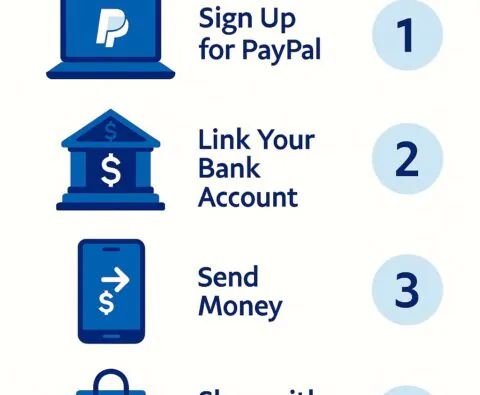Pay, Send and Save Money with PayPal | PayPal US | Guide
In today’s digital world, managing your finances online has never been easier. PayPal, a pioneer in online payments since 1998, remains one of the most trusted platforms for sending, receiving, and saving money. Whether you’re splitting a bill with friends, paying for services abroad, or managing your personal savings, PayPal offers a user-friendly, secure, and efficient solution.
This guide will walk you through how to send money, save money, avoid unnecessary fees, and maximize the benefits of using PayPal.
Why Choose PayPal?
PayPal is available in over 200 countries and supports 25 currencies, making it ideal for both international and domestic transactions. Its strong reputation for security, buyer protection policies, and ease of use have made it a go-to service for individuals and businesses alike.
Some standout reasons to use PayPal include:
-
Speed: Money transfers are almost instantaneous.
-
Security: Advanced encryption and fraud protection systems.
-
Convenience: Mobile apps, desktop access, and integration with thousands of online retailers.
-
Flexibility: Link multiple bank accounts, debit cards, and credit cards.
How to Send Money with PayPal
Sending money with PayPal is straightforward, but it’s important to understand your options to avoid unnecessary fees.
Step 1: Set Up Your PayPal Account
To send money, you first need a PayPal account:
-
Visit paypal.com.
-
Click on “Sign Up” and choose either a personal or business account.
-
Link a bank account, debit card, or credit card to fund your transactions.
Step 2: Choose the Right Payment Option
Once your account is set up:
-
Log in to PayPal.
-
Click “Send & Request.”
-
Choose “Send to Friends and Family” for a personal payment (fee-free if funded by your PayPal balance or linked bank account in the same country).
-
Select “Pay for Goods and Services” if you’re buying something—this provides purchase protection but may include a small fee.
Step 3: Enter Recipient Details
You can send money using:
-
An email address,
-
A mobile number, or
-
A PayPal.Me link (if they have one).
Enter the amount, add a note if you like, and click “Send.”
Tip: Always double-check the email address or phone number to avoid sending money to the wrong person.
How to Save Money Using PayPal
PayPal can also help you save money—both literally (with PayPal Savings accounts) and by avoiding fees strategically.
1. Use PayPal Savings
In 2022, PayPal introduced “PayPal Savings,” an online savings account powered by Synchrony Bank. It offers:
-
Competitive interest rates (often much higher than traditional banks),
-
No monthly fees or minimum balance requirements, and
-
FDIC insurance up to $250,000.
To open a PayPal Savings account:
-
Log into PayPal.
-
Navigate to the “Finances” tab.
-
Click on “PayPal Savings” and follow the prompts.
You can set goals (like “Vacation Fund” or “Emergency Savings”) and track your progress visually, making saving feel more rewarding.
2. Avoid Paying Fees When Sending Money
-
Use your PayPal balance or linked bank account to fund personal payments—not a credit card (which incurs a 2.9% fee plus a fixed fee).
-
Send in the same currency when possible to avoid foreign exchange fees.
-
Use Friends and Family for non-commercial transfers.
3. Find Deals and Cashbacks
-
PayPal Honey browser extension automatically finds coupons and discounts when you shop online.
-
The PayPal Offers section features cashback deals from partnered stores and brands.
-
Some credit cards linked to PayPal offer cashback bonuses for purchases made through PayPal.
How Much Does PayPal Charge?
Understanding PayPal’s fee structure is key to saving money.
-
Sending Money to Friends/Family in the Same Country: Free if funded by PayPal balance or a linked bank account.
-
Sending Money Internationally: Fees vary (generally 5% of the amount sent, capped at a maximum fee).
-
Paying with a Credit or Debit Card: 2.9% fee plus a fixed fee.
-
Receiving Money for Goods/Services: Seller pays 2.9% plus a fixed fee per transaction.
-
Currency Conversion Fee: 3–4% above the base exchange rate.
Always review the “Fees” section on PayPal before making large transactions.
Tips to Maximize Your PayPal Experience
1. Verify Your Account
Verifying your PayPal account by linking and confirming a bank account lifts many limits on how much you can send and withdraw and enhances account security.
2. Enable Two-Factor Authentication
Security should be a top priority. Enable two-step verification in your PayPal settings to protect your account from unauthorized access.
3. Be Wary of Scams
Always verify emails and never click suspicious links claiming to be from PayPal. Genuine PayPal emails will address you by your full name, not generic greetings like “Dear Customer.”
4. Use PayPal Credit Wisely
PayPal offers a “PayPal Credit” feature, essentially a digital line of credit. It can be useful for spreading out payments, especially when promotional no-interest periods apply—but always read the fine print to avoid interest fees.
Sending Money Internationally with PayPal
PayPal is an excellent tool for international money transfers, but it’s not always the cheapest compared to specialized services like Wise or Remitly. Still, it’s faster and more secure for many people.
When sending internationally:
-
Check the recipient’s country to confirm PayPal availability.
-
Review currency conversion rates.
-
Use the “Friends and Family” option if appropriate to lower fees.
-
Compare PayPal’s fees against other services if you’re sending large sums.
PayPal Alternatives for Saving More
While PayPal is convenient, there are times when an alternative service might save you more money:
-
Wise (formerly TransferWise) offers better currency exchange rates.
-
Venmo (owned by PayPal) is great for casual domestic payments between friends.
-
Zelle offers free bank-to-bank transfers within the U.S.
-
Revolut or Cash App can also be cost-effective depending on your needs.
Still, PayPal’s widespread acceptance, reliability, and features make it hard to beat for many users.
Final Thoughts
PayPal remains a trusted, efficient tool for sending, receiving, and saving money. Whether you’re paying a friend back for dinner, sending money abroad, managing your savings goals, or shopping online, PayPal provides a secure and easy-to-use platform.
By understanding PayPal’s features, fees, and tips to maximize your savings, you can make the most of your online financial transactions. As with any financial tool, staying informed and vigilant will ensure that you send and save money smartly—and securely.









